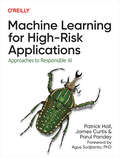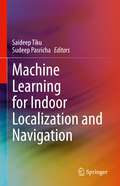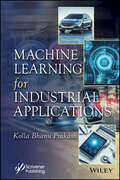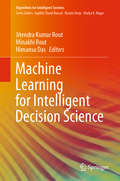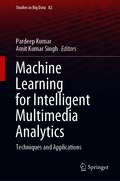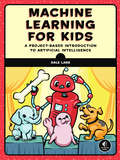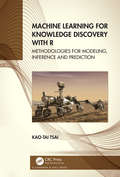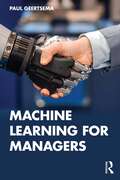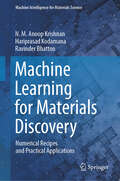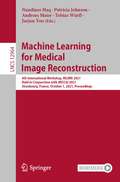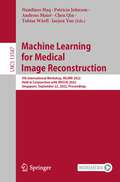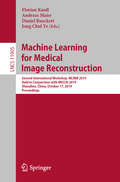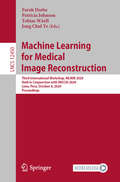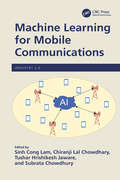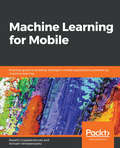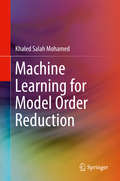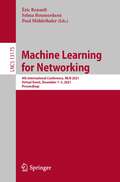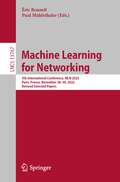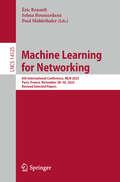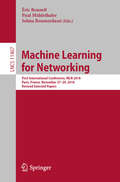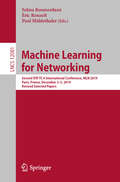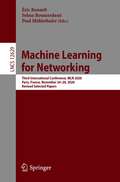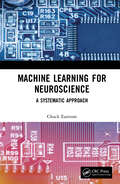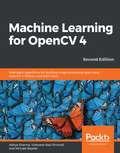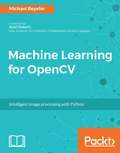- Table View
- List View
Machine Learning for High-Risk Applications: Approaches to Responsible AI
by Patrick Hall James Curtis Parul PandeyThe past decade has witnessed the broad adoption of artificial intelligence and machine learning (AI/ML) technologies. However, a lack of oversight in their widespread implementation has resulted in some incidents and harmful outcomes that could have been avoided with proper risk management. Before we can realize AI/ML's true benefit, practitioners must understand how to mitigate its risks. This book describes approaches to responsible AI—a holistic framework for improving AI/ML technology, business processes, and cultural competencies that builds on best practices in risk management, cybersecurity, data privacy, and applied social science. Authors Patrick Hall, James Curtis, and Parul Pandey created this guide for data scientists who want to improve real-world AI/ML system outcomes for organizations, consumers, and the public. Learn technical approaches for responsible AI across explainability, model validation and debugging, bias management, data privacy, and ML securityLearn how to create a successful and impactful AI risk management practiceGet a basic guide to existing standards, laws, and assessments for adopting AI technologies, including the new NIST AI Risk Management FrameworkEngage with interactive resources on GitHub and Colab
Machine Learning for Indoor Localization and Navigation
by Sudeep Pasricha Saideep TikuWhile GPS is the de-facto solution for outdoor positioning with a clear sky view, there is no prevailing technology for GPS-deprived areas, including dense city centers, urban canyons, buildings and other covered structures, and subterranean facilities such as underground mines, where GPS signals are severely attenuated or totally blocked. As an alternative to GPS for the outdoors, indoor localization using machine learning is an emerging embedded and Internet of Things (IoT) application domain that is poised to reinvent the way we navigate in various indoor environments. This book discusses advances in the applications of machine learning that enable the localization and navigation of humans, robots, and vehicles in GPS-deficient environments. The book explores key challenges in the domain, such as mobile device resource limitations, device heterogeneity, environmental uncertainties, wireless signal variations, and security vulnerabilities. Countering these challenges can improve the accuracy, reliability, predictability, and energy-efficiency of indoor localization and navigation. The book identifies severalnovel energy-efficient, real-time, and robust indoor localization techniques that utilize emerging deep machine learning and statistical techniques to address the challenges for indoor localization and navigation. In particular, the book:Provides comprehensive coverage of the application of machine learning to the domain of indoor localization;Presents techniques to adapt and optimize machine learning models for fast, energy-efficient indoor localization;Covers design and deployment of indoor localization frameworks on mobile, IoT, and embedded devices in real conditions.
Machine Learning for Industrial Applications
by Kolla Bhanu PrakashThe main goal of the book is to provide a comprehensive and accessible guide that empowers readers to understand, apply, and leverage machine learning algorithms and techniques effectively in real-world scenarios. Welcome to the exciting world of machine learning! In recent years, machine learning has rapidly transformed from a niche field within computer science to a fundamental technology shaping various aspects of our lives. Whether you realize it or not, machine learning algorithms are at work behind the scenes, powering recommendation systems, autonomous vehicles, virtual assistants, medical diagnostics, and much more. This book is designed to serve as your comprehensive guide to understanding the principles, algorithms, and applications of machine learning. Whether a student diving into this field for the first time, a seasoned professional looking to broaden your skillset, or an enthusiast eager to explore cutting-edge advancements, this book has something for you. The primary goal of Machine Learning for Industrial Applications is to demystify machine learning and make it accessible to a wide audience. It provides a solid foundation in the fundamental concepts of machine learning, covering both the theoretical underpinnings and practical applications. Whether you’re interested in supervised learning, unsupervised learning, reinforcement learning, or innovative techniques like deep learning, you’ll find comprehensive coverage here. Throughout the book, a hands-on approach is emphasized. As the best way to learn machine learning is by doing, the book includes numerous examples, exercises, and real-world case studies to reinforce your understanding and practical skills. Audience The book will enjoy a wide readership as it will appeal to all researchers, students, and technology enthusiasts wanting a hands-on guide to the new advances in machine learning.
Machine Learning for Intelligent Decision Science (Algorithms for Intelligent Systems)
by Himansu Das Minakhi Rout Jitendra Kumar RoutThe book discusses machine learning-based decision-making models, and presents intelligent, hybrid and adaptive methods and tools for solving complex learning and decision-making problems under conditions of uncertainty. Featuring contributions from data scientists, practitioners and educators, the book covers a range of topics relating to intelligent systems for decision science, and examines recent innovations, trends, and practical challenges in the field. The book is a valuable resource for academics, students, researchers and professionals wanting to gain insights into decision-making.
Machine Learning for Intelligent Multimedia Analytics: Techniques and Applications (Studies in Big Data #82)
by Amit Kumar Singh Pardeep KumarThis book presents applications of machine learning techniques in processing multimedia large-scale data. Multimedia such as text, image, audio, video, and graphics stands as one of the most demanding and exciting aspects of the information era. The book discusses new challenges faced by researchers in dealing with these large-scale data and also presents innovative solutions to address several potential research problems, e.g., enabling comprehensive visual classification to fill the semantic gap by exploring large-scale data, offering a promising frontier for detailed multimedia understanding, as well as extract patterns and making effective decisions by analyzing the large collection of data.
Machine Learning for Kids: A Project-Based Introduction to Artificial Intelligence
by Dale LaneA hands-on, application-based introduction to machine learning and artificial intelligence (AI) that guides young readers through creating compelling AI-powered games and applications using the Scratch programming language.Machine learning (also known as ML) is one of the building blocks of AI, or artificial intelligence. AI is based on the idea that computers can learn on their own, with your help. Machine Learning for Kids will introduce you to machine learning, painlessly. With this book and its free, Scratch-based, award-winning companion website, you'll see how easy it is to add machine learning to your own projects. You don't even need to know how to code! As you work through the book you'll discover how machine learning systems can be taught to recognize text, images, numbers, and sounds, and how to train your models to improve their accuracy. You'll turn your models into fun computer games and apps, and see what happens when they get confused by bad data. You'll build 13 projects step-by-step from the ground up, including: • Rock, Paper, Scissors game that recognizes your hand shapes • An app that recommends movies based on other movies that you like • A computer character that reacts to insults and compliments • An interactive virtual assistant (like Siri or Alexa) that obeys commands • An AI version of Pac-Man, with a smart character that knows how to avoid ghosts NOTE: This book includes a Scratch tutorial for beginners, and step-by-step instructions for every project.Ages 12+
Machine Learning for Knowledge Discovery with R: Methodologies for Modeling, Inference and Prediction
by Kao-Tai TsaiMachine Learning for Knowledge Discovery with R contains methodologies and examples for statistical modelling, inference, and prediction of data analysis. It includes many recent supervised and unsupervised machine learning methodologies such as recursive partitioning modelling, regularized regression, support vector machine, neural network, clustering, and causal-effect inference. Additionally, it emphasizes statistical thinking of data analysis, use of statistical graphs for data structure exploration, and result presentations. The book includes many real-world data examples from life-science, finance, etc. to illustrate the applications of the methods described therein. Key Features: Contains statistical theory for the most recent supervised and unsupervised machine learning methodologies. Emphasizes broad statistical thinking, judgment, graphical methods, and collaboration with subject-matter-experts in analysis, interpretation, and presentations. Written by statistical data analysis practitioner for practitioners. The book is suitable for upper-level-undergraduate or graduate-level data analysis course. It also serves as a useful desk-reference for data analysts in scientific research or industrial applications.
Machine Learning for Managers
by Paul GeertsemaMachine learning can help managers make better predictions, automate complex tasks and improve business operations. Managers who are familiar with machine learning are better placed to navigate the increasingly digital world we live in. There is a view that machine learning is a highly technical subject that can only be understood by specialists. However, many of the ideas that underpin machine learning are straightforward and accessible to anyone with a bit of curiosity. This book is for managers who want to understand what machine learning is about, but who lack a technical background in computer science, statistics or math. The book describes in plain language what machine learning is and how it works. In addition, it explains how to manage machine learning projects within an organization. This book should appeal to anyone that wants to learn more about using machine learning to drive value in real-world organizations.
Machine Learning for Materials Discovery: Numerical Recipes and Practical Applications (Machine Intelligence for Materials Science)
by Hariprasad Kodamana Ravinder Bhattoo N. M. KrishnanFocusing on the fundamentals of machine learning, this book covers broad areas of data-driven modeling, ranging from simple regression to advanced machine learning and optimization methods for applications in materials modeling and discovery. The book explains complex mathematical concepts in a lucid manner to ensure that readers from different materials domains are able to use these techniques successfully. A unique feature of this book is its hands-on aspect—each method presented herein is accompanied by a code that implements the method in open-source platforms such as Python. This book is thus aimed at graduate students, researchers, and engineers to enable the use of data-driven methods for understanding and accelerating the discovery of novel materials.
Machine Learning for Medical Image Reconstruction: 4th International Workshop, MLMIR 2021, Held in Conjunction with MICCAI 2021, Strasbourg, France, October 1, 2021, Proceedings (Lecture Notes in Computer Science #12964)
by Patricia Johnson Andreas Maier Tobias Würfl Nandinee Haq Jaejun YooThis book constitutes the refereed proceedings of the 4th International Workshop on Machine Learning for Medical Reconstruction, MLMIR 2021, held in conjunction with MICCAI 2021, in October 2021. The workshop was planned to take place in Strasbourg, France, but was held virtually due to the COVID-19 pandemic. The 13 papers presented were carefully reviewed and selected from 20 submissions. The papers are organized in the following topical sections: deep learning for magnetic resonance imaging and deep learning for general image reconstruction.
Machine Learning for Medical Image Reconstruction: 5th International Workshop, MLMIR 2022, Held in Conjunction with MICCAI 2022, Singapore, September 22, 2022, Proceedings (Lecture Notes in Computer Science #13587)
by Patricia Johnson Andreas Maier Tobias Würfl Nandinee Haq Jaejun Yoo Chen QinThis book constitutes the refereed proceedings of the 5th International Workshop on Machine Learning for Medical Reconstruction, MLMIR 2022, held in conjunction with MICCAI 2022, in September 2022, held in Singapore.The 15 papers presented were carefully reviewed and selected from 19 submissions. The papers are organized in the following topical sections: deep learning for magnetic resonance imaging and deep learning for general image reconstruction.
Machine Learning for Medical Image Reconstruction: Second International Workshop, MLMIR 2019, Held in Conjunction with MICCAI 2019, Shenzhen, China, October 17, 2019, Proceedings (Lecture Notes in Computer Science #11905)
by Daniel Rueckert Andreas Maier Florian Knoll Jong Chul YeThis book constitutes the refereed proceedings of the Second International Workshop on Machine Learning for Medical Reconstruction, MLMIR 2019, held in conjunction with MICCAI 2019, in Shenzhen, China, in October 2019. The 24 full papers presented were carefully reviewed and selected from 32 submissions. The papers are organized in the following topical sections: deep learning for magnetic resonance imaging; deep learning for computed tomography; and deep learning for general image reconstruction.
Machine Learning for Medical Image Reconstruction: Third International Workshop, MLMIR 2020, Held in Conjunction with MICCAI 2020, Lima, Peru, October 8, 2020, Proceedings (Lecture Notes in Computer Science #12450)
by Patricia Johnson Jong Chul Ye Farah Deeba Tobias WürflThis book constitutes the refereed proceedings of the Third International Workshop on Machine Learning for Medical Reconstruction, MLMIR 2020, held in conjunction with MICCAI 2020, in Lima, Peru, in October 2020. The workshop was held virtually. The 15 papers presented were carefully reviewed and selected from 18 submissions. The papers are organized in the following topical sections: deep learning for magnetic resonance imaging and deep learning for general image reconstruction.
Machine Learning for Mobile Communications (Industry 5.0)
by Chiranji Lal Chowdhary Subrata Chowdhury Sinh Cong Lam Tushar Hrishikesh JawareMachine Learning for Mobile Communications will take readers on a journey from basic to advanced knowledge about mobile communications and machine learning. For learners at the basic level, this book volume discusses a wide range of mobile communications topics from the system level, such as system design and optimization, to the user level, such as power control and resource allocation. The authors also review state-of-the-art machine learning, one of the biggest emerging trends in both academia and industry. For learners at the advanced level, this book discusses solutions for long-term problems with future mobile communications such as resource allocation, security, power control, and spectral efficiency. The book brings together some of the top mobile communications and machine learning experts throughout the world, who contributed their knowledge and experience regarding system design and optimization.This book: Discusses the 5G new radio system design and architecture as specified in 3GPP documents Highlights the challenges including security and privacy, energy, and spectrum efficiency from the perspective of 5G new radio systems Identifies both theoretical and practical problems that can occur in mobile communication systems Covers machine learning techniques such as autoencoder and Q-learning in a comprehensive manner Explores how to apply machine learning techniques to mobile systems to solve modern problems This book is for senior undergraduate and graduate students and academic researchers in the fields of electrical engineering, electronics and communication engineering, and computer engineering.
Machine Learning for Mobile: Practical guide to building intelligent mobile applications powered by machine learning
by Revathi Gopalakrishnan Avinash VenkateswarluLeverage the power of machine learning on mobiles and build intelligent mobile applications with ease Key Features Build smart mobile applications for Android and iOS devices Use popular machine learning toolkits such as Core ML and TensorFlow Lite Explore cloud services for machine learning that can be used in mobile apps Book Description Machine learning presents an entirely unique opportunity in software development. It allows smartphones to produce an enormous amount of useful data that can be mined, analyzed, and used to make predictions. This book will help you master machine learning for mobile devices with easy-to-follow, practical examples. You will begin with an introduction to machine learning on mobiles and grasp the fundamentals so you become well-acquainted with the subject. You will master supervised and unsupervised learning algorithms, and then learn how to build a machine learning model using mobile-based libraries such as Core ML, TensorFlow Lite, ML Kit, and Fritz on Android and iOS platforms. In doing so, you will also tackle some common and not-so-common machine learning problems with regard to Computer Vision and other real-world domains. By the end of this book, you will have explored machine learning in depth and implemented on-device machine learning with ease, thereby gaining a thorough understanding of how to run, create, and build real-time machine-learning applications on your mobile devices. What you will learn Build intelligent machine learning models that run on Android and iOS Use machine learning toolkits such as Core ML, TensorFlow Lite, and more Learn how to use Google Mobile Vision in your mobile apps Build a spam message detection system using Linear SVM Using Core ML to implement a regression model for iOS devices Build image classification systems using TensorFlow Lite and Core ML Who this book is for If you are a mobile app developer or a machine learning enthusiast keen to use machine learning to build smart mobile applications, this book is for you. Some experience with mobile application development is all you need to get started with this book. Prior experience with machine learning will be an added bonus
Machine Learning for Model Order Reduction
by Khaled Salah MohamedThis Book discusses machine learning for model order reduction, which can be used in modern VLSI design to predict the behavior of an electronic circuit, via mathematical models that predict behavior. The author describes techniques to reduce significantly the time required for simulations involving large-scale ordinary differential equations, which sometimes take several days or even weeks. This method is called model order reduction (MOR), which reduces the complexity of the original large system and generates a reduced-order model (ROM) to represent the original one. Readers will gain in-depth knowledge of machine learning and model order reduction concepts, the tradeoffs involved with using various algorithms, and how to apply the techniques presented to circuit simulations and numerical analysis.Introduces machine learning algorithms at the architecture level and the algorithm levels of abstraction;Describes new, hybrid solutions for model order reduction;Presents machine learning algorithms in depth, but simply;Uses real, industrial applications to verify algorithms.
Machine Learning for Networking: 4th International Conference, MLN 2021, Virtual Event, December 1–3, 2021, Proceedings (Lecture Notes in Computer Science #13175)
by Selma Boumerdassi Éric Renault Paul MühlethalerThis book constitutes the thoroughly refereed proceedings of the 4th International Conference on Machine Learning for Networking, MLN 2021, held in Paris, France, in December 2021. The 10 revised full papers included in the volume were carefully reviewed and selected from 30 submissions. They present and discuss new trends in in deep and reinforcement learning, pattern recognition and classification for networks, machine learning for network slicing optimization, 5G systems, user behavior prediction, multimedia, IoT, security and protection, optimization and new innovative machine learning methods, performance analysis of machine learning algorithms, experimental evaluations of machine learning, data mining in heterogeneous networks, distributed and decentralized machine learning algorithms, intelligent cloud-support communications, resource allocation, energy-aware communications, software-defined networks, cooperative networks, positioning and navigation systems, wireless communications, wireless sensor networks, and underwater sensor networks.
Machine Learning for Networking: 5th International Conference, MLN 2022, Paris, France, November 28–30, 2022, Revised Selected Papers (Lecture Notes in Computer Science #13767)
by Éric Renault Paul MühlethalerThis book constitutes the post-conference proceedings of the 5th International Conference on Machine Learning for Networking, MLN 2022, held in Paris, France, November 28–30, 2022. The 12 full papers presented in this book were carefully reviewed and selected from 27 submissions. The papers present novel ideas, results, experiences and work-in-process on all aspects of Machine Learning and Networking.
Machine Learning for Networking: 6th International Conference, MLN 2023, Paris, France, November 28–30, 2023, Revised Selected Papers (Lecture Notes in Computer Science #14525)
by Selma Boumerdassi Éric Renault Paul MühlethalerThis book constitutes the refereed proceedings of the 6th International Conference on Machine Learning for Networking, MLN 2023, held in Paris, France, during November 28–30, 2023. The 18 full papers included in this book were carefully reviewed and selected from 34 submissions. The conference aims at providing a top forum for researchers and practitioners to present and discuss new trends in machine learning, deep learning, pattern recognition and optimization for network architectures and services.
Machine Learning for Networking: First International Conference, MLN 2018, Paris, France, November 27–29, 2018, Revised Selected Papers (Lecture Notes in Computer Science #11407)
by Selma Boumerdassi Éric Renault Paul MühlethalerThis book constitutes the thoroughly refereed proceedings of the First International Conference on Machine Learning for Networking, MLN 2018, held in Paris, France, in November 2018. The 22 revised full papers included in the volume were carefully reviewed and selected from 48 submissions. They present new trends in the following topics: Deep and reinforcement learning; Pattern recognition and classification for networks; Machine learning for network slicing optimization, 5G system, user behavior prediction, multimedia, IoT, security and protection; Optimization and new innovative machine learning methods; Performance analysis of machine learning algorithms; Experimental evaluations of machine learning; Data mining in heterogeneous networks; Distributed and decentralized machine learning algorithms; Intelligent cloud-support communications, resource allocation, energy-aware/green communications, software defined networks, cooperative networks, positioning and navigation systems, wireless communications, wireless sensor networks, underwater sensor networks.
Machine Learning for Networking: Second IFIP TC 6 International Conference, MLN 2019, Paris, France, December 3–5, 2019, Revised Selected Papers (Lecture Notes in Computer Science #12081)
by Selma Boumerdassi Éric Renault Paul MühlethalerThis book constitutes the thoroughly refereed proceedings of the Second International Conference on Machine Learning for Networking, MLN 2019, held in Paris, France, in December 2019. The 26 revised full papers included in the volume were carefully reviewed and selected from 75 submissions. They present and discuss new trends in deep and reinforcement learning, patternrecognition and classi cation for networks, machine learning for network slicingoptimization, 5G system, user behavior prediction, multimedia, IoT, securityand protection, optimization and new innovative machine learning methods, performanceanalysis of machine learning algorithms, experimental evaluations ofmachine learning, data mining in heterogeneous networks, distributed and decentralizedmachine learning algorithms, intelligent cloud-support communications,ressource allocation, energy-aware communications, software de ned networks,cooperative networks, positioning and navigation systems, wireless communications,wireless sensor networks, underwater sensor networks.
Machine Learning for Networking: Third International Conference, MLN 2020, Paris, France, November 24–26, 2020, Revised Selected Papers (Lecture Notes in Computer Science #12629)
by Selma Boumerdassi Éric Renault Paul MühlethalerThis book constitutes the thoroughly refereed proceedings of the Second International Conference on Machine Learning for Networking, MLN 2019, held in Paris, France, in December 2019. The 26 revised full papers included in the volume were carefully reviewed and selected from 75 submissions. They present and discuss new trends in deep and reinforcement learning, pattern recognition and classification for networks, machine learning for network slicing optimization, 5G system, user behavior prediction, multimedia, IoT, security and protection, optimization and new innovative machine learning methods, performance analysis of machine learning algorithms, experimental evaluations of machine learning, data mining in heterogeneous networks, distributed and decentralized machine learning algorithms, intelligent cloud-support communications, ressource allocation, energy-aware communications, software de ned networks, cooperative networks, positioning and navigation systems, wireless communications, wireless sensor networks, underwater sensor networks.
Machine Learning for Neuroscience: A Systematic Approach
by Chuck EasttomThis book addresses the growing need for machine learning and data mining in neuroscience. The book offers a basic overview of the neuroscience, machine learning and the required math and programming necessary to develop reliable working models. The material is presented in a easy to follow user-friendly manner and is replete with fully working machine learning code. Machine Learning for Neuroscience: A Systematic Approach, tackles the needs of neuroscience researchers and practitioners that have very little training relevant to machine learning. The first section of the book provides an overview of necessary topics in order to delve into machine learning, including basic linear algebra and Python programming. The second section provides an overview of neuroscience and is directed to the computer science oriented readers. The section covers neuroanatomy and physiology, cellular neuroscience, neurological disorders and computational neuroscience. The third section of the book then delves into how to apply machine learning and data mining to neuroscience and provides coverage of artificial neural networks (ANN), clustering, and anomaly detection. The book contains fully working code examples with downloadable working code. It also contains lab assignments and quizzes, making it appropriate for use as a textbook. The primary audience is neuroscience researchers who need to delve into machine learning, programmers assigned neuroscience related machine learning projects and students studying methods in computational neuroscience.
Machine Learning for OpenCV 4: Intelligent algorithms for building image processing apps using OpenCV 4, Python, and scikit-learn, 2nd Edition
by Michael Beyeler Aditya Sharma Vishwesh Ravi ShrimaliA practical guide to understanding the core machine learning and deep learning algorithms, and implementing them to create intelligent image processing systems using OpenCV 4 Key Features Gain insights into machine learning algorithms, and implement them using OpenCV 4 and scikit-learn Get up to speed with Intel OpenVINO and its integration with OpenCV 4 Implement high-performance machine learning models with helpful tips and best practices Book Description OpenCV is an opensource library for building computer vision apps. The latest release, OpenCV 4, offers a plethora of features and platform improvements that are covered comprehensively in this up-to-date second edition. You'll start by understanding the new features and setting up OpenCV 4 to build your computer vision applications. You will explore the fundamentals of machine learning and even learn to design different algorithms that can be used for image processing. Gradually, the book will take you through supervised and unsupervised machine learning. You will gain hands-on experience using scikit-learn in Python for a variety of machine learning applications. Later chapters will focus on different machine learning algorithms, such as a decision tree, support vector machines (SVM), and Bayesian learning, and how they can be used for object detection computer vision operations. You will then delve into deep learning and ensemble learning, and discover their real-world applications, such as handwritten digit classification and gesture recognition. Finally, you'll get to grips with the latest Intel OpenVINO for building an image processing system. By the end of this book, you will have developed the skills you need to use machine learning for building intelligent computer vision applications with OpenCV 4. What you will learn Understand the core machine learning concepts for image processing Explore the theory behind machine learning and deep learning algorithm design Discover effective techniques to train your deep learning models Evaluate machine learning models to improve the performance of your models Integrate algorithms such as support vector machines and Bayes classifier in your computer vision applications Use OpenVINO with OpenCV 4 to speed up model inference Who this book is for This book is for Computer Vision professionals, machine learning developers, or anyone who wants to learn machine learning algorithms and implement them using OpenCV 4. If you want to build real-world Computer Vision and image processing applications powered by machine learning, then this book is for you. Working knowledge of Python programming is required to get the most out of this book.
Machine Learning for OpenCV: Intelligent Algorithms For Building Image Processing Apps Using Opencv 4, Python, And Scikit-learn, 2nd Edition
by Michael BeyelerExpand your OpenCV knowledge and master key concepts of machine learning using this practical, hands-on guide. About This Book • Load, store, edit, and visualize data using OpenCV and Python • Grasp the fundamental concepts of classification, regression, and clustering • Understand, perform, and experiment with machine learning techniques using this easy-to-follow guide • Evaluate, compare, and choose the right algorithm for any task Who This Book Is For This book targets Python programmers who are already familiar with OpenCV; this book will give you the tools and understanding required to build your own machine learning systems, tailored to practical real-world tasks. What You Will Learn • Explore and make effective use of OpenCV's machine learning module • Learn deep learning for computer vision with Python • Master linear regression and regularization techniques • Classify objects such as flower species, handwritten digits, and pedestrians • Explore the effective use of support vector machines, boosted decision trees, and random forests • Get acquainted with neural networks and Deep Learning to address real-world problems • Discover hidden structures in your data using k-means clustering • Get to grips with data pre-processing and feature engineering In Detail Machine learning is no longer just a buzzword, it is all around us: from protecting your email, to automatically tagging friends in pictures, to predicting what movies you like. Computer vision is one of today's most exciting application fields of machine learning, with Deep Learning driving innovative systems such as self-driving cars and Google's DeepMind. OpenCV lies at the intersection of these topics, providing a comprehensive open-source library for classic as well as state-of-the-art computer vision and machine learning algorithms. In combination with Python Anaconda, you will have access to all the open-source computing libraries you could possibly ask for. Machine learning for OpenCV begins by introducing you to the essential concepts of statistical learning, such as classification and regression. Once all the basics are covered, you will start exploring various algorithms such as decision trees, support vector machines, and Bayesian networks, and learn how to combine them with other OpenCV functionality. As the book progresses, so will your machine learning skills, until you are ready to take on today's hottest topic in the field: Deep Learning. By the end of this book, you will be ready to take on your own machine learning problems, either by building on the existing source code or developing your own algorithm from scratch! Style and approach OpenCV machine learning connects the fundamental theoretical principles behind machine learning to their practical applications in a way that focuses on asking and answering the right questions. This book walks you through the key elements of OpenCV and its powerful machine learning classes, while demonstrating how to get to grips with a range of models.
